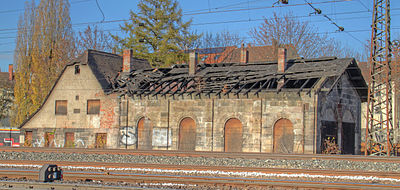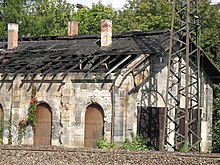Locomotive shed (Fürth)
The locomotive shed in Fürth is located near the city limits underground station and is a listed building . It is the oldest monument in the railway history of Middle Franconia and one of the oldest still preserved locomotive sheds in Germany.
history
The locomotive shed was built around 1860 with the Nuremberg – Würzburg railway line or possibly - but less likely due to the distance to the line - as early as 1844 ff. As part of the Ludwig-Süd-Nord-Bahn and in connection with the so-called “ Fürth Crossing ”. It was used for storing shunting locomotives of the state railway and possibly for the LEG - Phoenix and Adler II of the Ludwigseisenbahn. The shunting locomotives were initially supposed to be used to exchange wagons between the state railway and the private Ludwig railway . Up to four shunting locomotives could be parked on the two tracks. Each of the tracks was provided with a pit for maintenance work. There was a water storage tank (partially still preserved today) in the attic to be able to supply the locomotives with water.
In 1911 a residential and workshop extension was built at the top of the shed and a shed (shed or field smithy) near the approach side . All three parts of the building are listed under the file number D-5-63-000-1595, the official address is Karolinenstraße 91.
The German railway used the building until the end of the 1980s. After that it came to decay, which, according to the Lower Monument Protection Authority in the city of Fürth, can be traced back to the "years of neglect of necessary minimum measures for proper building maintenance". In the mid-1990s, the two tracks that led to the shed were dismantled. In 2002 the engine shed became the property of the real estate developer Aurelis , who opposed any securing of the building's existence (including in court).
Since December 12, 2010, the Nuremberg S-Bahn (S 1) has been passing in the immediate vicinity on newly built tracks. In 2012, the declared DB Museum in Nuremberg ready to roundhouse after a translocation to set up on their outdoor area, but moved in 2014 from this commitment again. At the end of 2015, Aurelis sold the locomotive shed to the Fürth investor P & P, who promised to use it and thus maintain it. The previous owner Aurelis - presumably the transfer has not yet been completed by a notary - submitted a demolition application, which was negotiated in April 2016 and was initially postponed. In November 2016, P&P CEO Michael Peter again promised to secure and renovate the building, including the depot, and the lawsuit would be withdrawn.
After purchasing the building, the new owner started the first security measures. For the time being, a transition roof protects the building from the weather. After consultation with the State Office for Monument Preservation, the engine shed is to be renovated and thus preserved for posterity. The owner plans to use the building for commercial, office and residential purposes.
Building fabric
The locomotive shed was built from sandstone blocks with two tracks, maintenance facilities for steam locomotives and a bitumen- covered roof with a wooden roof ( saddle roof ).
The two buildings that were added later (residential building and coach house) were made of brick and plastered. They received a covered roof with a roof made of wood . The roof of the residential building was designed as a crooked roof .
Before 2004, the roof of the locomotive shed was badly damaged by fire. The building is threatened with demolition or demolition.
Web links
- Monument Network Bavaria: Locomotive shed from 1860 - Germany's oldest preserved locomotive shed is rotting .
- Alexander Mayer: How the rescue of the locomotive shed was messed up . In: Fürther Freiheit from November 6, 2015.
- Volker Dittmar: The most important homework in the monument city of Fürth . In: Nordbayern.de from January 7, 2014.
- Volker Dittmar: Locksmith interested in the engine shed . In: Nordbayern.de of September 17, 2011.
- Voker Dittmar: New attempt to rescue . In: Nordbayern.de of August 26, 2011.
- Volker Dittmar: Unique railway monument is in ruins . In: Nordbayern.de of March 12, 2011.
- Alexander Mayer: The engine shed continues to fall into disrepair . In: Circular letter of the city home keeper No. 67 from February 27, 2011, p. 6.
- Alexander Mayer: Guided tour of the history of traffic in Fürth . In: Circular letter from the town councilor No. 66 from September 10, 2010.
- Volker Dittmar: Hope for engine sheds again . In: Nordbayern.de of March 22, 2007.
- Historic engine shed is being renovated . On: fuerth.de - city news from April 21, 2006.
- FürthWiki: - Picture gallery .
literature
- Alexander Mayer: On water, on land and in the air . Sutton, Erfurt 2010, ISBN 978-3-86680-594-1 , p. 59 ff .
- Fürth history workshop (Jörg Schäfer, Werner Schmidt, Lothar Berthold): Railway town of Fürth. Fürth 2007. ISBN 3-927347-66-3 . P. 16 f., 22.
- Wolfgang Mück: Germany's first steam train. The royal private Ludwig Railway between Nuremberg and Fürth . Ed .: Association for local research "Alt-Fürth" (= Fürth contributions to history and local history . Volume 3 ). Spindler and Verein, Nuremberg and Fürth 1985, DNB 860658317 , p. 210 ff .
- Hans-Peter Schäfer: The beginnings of the Franconian railway . Würzburg 1985, ISBN 3-8003-0257-8 , pp. 41 ff .
Individual evidence
- ↑ Mayer: On water, on land and in the air. 2010. p. 63.
- ↑ Bavarian State Office for Monument Preservation: Architectural monuments in Fürth on geodaten.bayern.de, accessed on December 3, 2015
- ↑ Nordbayern.de of March 12, 2011: Unique railway monument expires .
- ↑ a b c Alexander Mayer: How the rescue of the locomotive shed was messed up . In: Fürther Freiheit from November 6, 2015.
- ↑ Nahverkehr-franken.de , accessed November 24, 2015.
- ↑ Nordbayern.de of March 12, 2011: Unique railway monument expires
- ↑ Nordbayern.de of December 5, 2015: City of Fürth wants to develop huge fallow land with P&P .
- ↑ Fürth: Tug of war for historic engine sheds in court . Nordbayern.de from May 5, 2016
- ↑ Johannes Alles: Make way: the engine shed is saved. In: Fürther Nachrichten of November 12, 2016, p. 33 and Nordbayern.de of November 14, 2016 (same text).
- ↑ Johannes Alles: Aurelis withdraws the complaint. In: Fürther Nachrichten of November 12, 2016, p. 33.
- ↑ Refurbishment of the locomotive shed starts at full steam ( Memento from October 14, 2018 in the Internet Archive ) on www.br.de from December 4, 2017
- ↑ Entry in the Bavarian Monument Atlas .
Coordinates: 49 ° 27 ′ 56.3 " N , 11 ° 0 ′ 34.3" E



